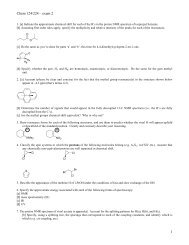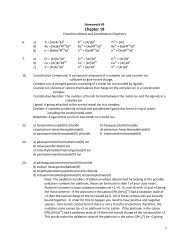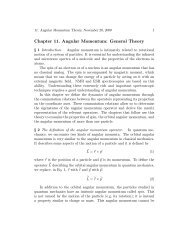Chapter 7. The Eigenvalue Problem
Chapter 7. The Eigenvalue Problem
Chapter 7. The Eigenvalue Problem
You also want an ePaper? Increase the reach of your titles
YUMPU automatically turns print PDFs into web optimized ePapers that Google loves.
<strong>7.</strong> <strong>The</strong> <strong>Eigenvalue</strong> <strong>Problem</strong>, December 17, 2009 16<br />
In the Schrödinger representation, the state |n, j, k is (see Metiu, Eq. 8.31)<br />
x, y, z | n, j, k ≡ ψ n,j,k (x, y, z)<br />
<br />
2<br />
= sin<br />
L x<br />
nπx<br />
L x<br />
2<br />
L y<br />
sin<br />
<br />
jπy 2 kπz<br />
sin<br />
L y L z L z<br />
(78)<br />
For the example of the cube,<br />
x, y, z | 2, 1, 1 =<br />
<br />
<br />
8 2πx<br />
L sin sin<br />
3 L<br />
πy<br />
sin<br />
L<br />
πz<br />
L<br />
(79)<br />
and<br />
x, y, z | 1, 2, 1 =<br />
<br />
8 πx<br />
L sin sin<br />
3 L<br />
2πy<br />
sin<br />
L<br />
πz<br />
L<br />
(80)<br />
A similar equation holds for x, y, z | 1, 1, 2. <strong>The</strong>se three states have the same<br />
energy but they are different states. What is the physical difference between<br />
them<br />
Let us look at the kinetic energy in the x-direction:<br />
ˆK x x, y, z | 2, 1, 1 = − ¯h2<br />
2m ∂x ψ 2,1,1(x, y, z)<br />
2<br />
<br />
= ¯h2 2π 2<br />
ψ 2,1,1 (x, y, z) (81)<br />
2m L<br />
I obtained the second line from the first by taking the second derivative of<br />
ψ 2,1,1 (x, y, z) givenbyEq.79. Weseethat|2, 1, 1 is an eigenstate of ˆKx ,<br />
<br />
with the eigenvalue ¯h2 2π 2.Inthesameway,youcanshowthat|2,<br />
2m L<br />
1, 1 is<br />
an eigenstate of ˆK y and ˆK<br />
<br />
z , with the eigenvalues ¯h2 1π 2.<br />
2m L <strong>The</strong> total energy<br />
is the sum of those three kinetic energies. In the state |2, 1, 1, the particle<br />
has higher kinetic energy in the x-direction. We can analyze in the same way<br />
the states |1, 2, 1 and |1, 1, 2. Table 1 gives the result. <strong>The</strong> three degenerate<br />
<br />
states have the high (i.e. ¯h2 2π 2)<br />
2m L kinetic energy in different directions.<br />
Can we distinguish these three states by some measurement We can.<br />
<strong>The</strong> particle in the state |2, 1, 1 will emit a photon in a different direction<br />
than will a particle in |1, 2, 1 or |1, 1, 2.<br />
<strong>The</strong> degenerate states |2, 1, 1, |1, 2, 1, and|1, 1, 2 are different physical<br />
states, even though they have the same energy.<br />
∂ 2

















